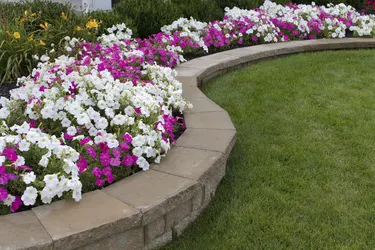
Homeowner's insurance policies are often referred to as all-risk coverage. The phrase "all risk" commonly implies a combination of property damage coverage and liability coverage; it does not mean every possible risk is covered. Insurance is regulated by states, and different states have differing common perils, meaning causes of loss. Also, different insurance companies offer varying products. Nonetheless, in an all-risk insurance policy, retaining walls are typically listed among exclusions.
A Common Exclusion
Video of the Day
The exclusion language listed in insurance policies can vary, but it is not uncommon for retaining walls, foundations and other structures that are not buildings to be excluded from coverage. Depending on your policy, any number of items such as swimming pools, fences or docks can be excluded. It does not matter if they collapse from the weight of water or ice, if they are under pressure or if they freeze and thaw. The place to look for the information that applies to a specific situation such as retaining wall is in the policy under its exclusions section.
Video of the Day
Other Causes Not Covered
Usually within the list of exclusions are a number of other specific causes the insurance does not cover. One of these is wear and tear. In other words, age and lack of maintenance are not covered. These are considered to be the homeowner's responsibility. Damage done by animals, whether the animals are burrowing rodents, birds or the homeowner's pets, is not covered. If a wall, even if it was not excluded, is damaged in this manner, it would not be covered. Another cause that is often excluded is known as settling. In the imagined scenario where the wall was covered, if the earth beneath it settles, settling is not likely to be covered. Still another type of damage not usually covered is water damage, including sewer backup.
Multiple Contributing Factors
In insurance terms, some things excluded from coverage are known as "concurrent causation exclusions." In an imaginary scenario, the retaining wall was not necessarily excluded, but the following happened: A burrowing animal dug under the retaining wall and left tunnels. A rain storm brought mud from a neighboring hillside property and pushed against the retaining wall. The mud filled in the tunnels. A freeze occurred. A thaw occurred. The retaining wall tipped over. When more than one event contributed to the loss, only the policy details about losses from multiple causes can shed light on why or why not coverage applies.
Special Types of Coverage
If a homeowner is concerned about a retaining wall or other aspect of the property, the time to consider insuring against loss is long before loss occurs. Flood insurance is made possible through a federal program for certain flood-prone areas, and homeowners can purchase flood insurance through insurance companies. Earthquake insurance may be available in regions where earthquakes are a danger and in some instances may be added to the homeowner's insurance under a special policy endorsement. In some hurricane-prone regions of the United States, hurricane insurance is available. In other states, such as in Pennsylvania, a nonprofit insurance fund offers affordable insurance to homeowners whose dwellings and other structures could be affected by the collapse of underground mines.